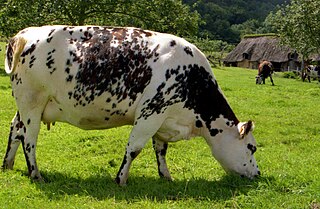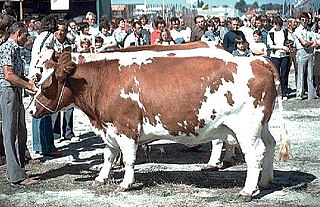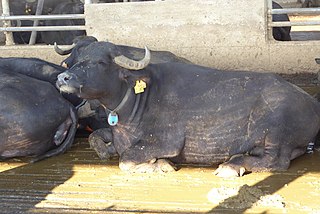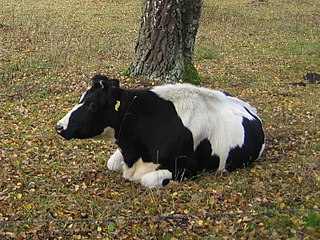Related Research Articles

Holstein Friesians are a breed of dairy cattle that originated in the Dutch provinces of North Holland and Friesland, and Schleswig-Holstein in Northern Germany. They are known as the world's highest-producing dairy animals.

Dairy cattle are cattle bred for the ability to produce large quantities of milk, from which dairy products are made. Dairy cattle generally are of the species Bos taurus.

The Dairy Shorthorn is a British breed of dairy cattle. It derives from the Shorthorn cattle of Tees-side, in the North Riding of Yorkshire and in Northumbria in north-eastern England. The Shorthorn was for this reason at first known as the Durham or Teeswater.

The Nigerian Dwarf is an American breed of dwarf goat. Like the American Pygmy Goat, it derives from the West African Dwarf group of breeds of West Africa.

The South Devon is a British breed of large beef cattle. It originated in the counties of Devon and Cornwall in south-west England, and is mentioned from the eighteenth century. It was a dual-purpose breed, kept both for its milk and for beef. Since 1972 selection has been for beef only.

The Gir or Gyr is one of the principal Zebu breeds originating in India. It has been used locally in the improvement of other breeds including the Red Sindhi and the Sahiwal. It was also one of the breeds used in the development of the Brahman breed in North America. In Brazil and other South American countries the Gir is used frequently because, as a Bos indicus breed, it is resistant to hot temperatures and tropical diseases. It is well known for its milk producing qualities and is often bred with Friesian cows to make the Girolando breed.

The Old Gloucester or Gloucester is a traditional British breed of cattle originating in Gloucestershire and surrounding areas in the West Country of England. It was originally a triple-purpose breed, reared for milk, for beef and for draught use; it is now a dual-purpose animal. It is an endangered breed, and its conservation status is listed as "priority" by the Rare Breeds Survival Trust.

The Montbéliarde is a breed of red pied dairy cattle from the area of Montbéliard, in the département of Doubs, in the Bourgogne-Franche-Comté region of eastern France. It is used mainly for dairying and particularly for cheesemaking.

The Normande is a breed of dairy cattle from the Normandy region of north-west France. It is raised principally for its milk, which is high in fat and suitable for making butter and cheese, but also for its meat, which is marbled and good-flavoured. It is a world breed: it has been exported to many countries and is present on all continents.

The Armoricaine or Armorican is an endangered French breed of domestic cattle. It originated in Brittany in the nineteenth century. It has a red coat with white markings, and has short horns.

The Pie Rouge des Plaines is a modern French breed of dairy cattle. It was created in about 1970 by cross-breeding the traditional Armorican cattle of Brittany, in north-western France, with red-pied cattle of the Dutch Meuse-Rhine-Yssel and German Deutsche Rotbunte breeds.
The Tipo Carora or Carora is a Venezuelan breed of dairy cattle. It was bred in the early part of the twentieth century by crossing of local Criollo cows with imported Brown Swiss bulls. It is named for its place of origin, the town of Carora in the Venezuelan state of Lara.
The Lucerna is a Colombian breed of dual-purpose cattle. It is a composite breed, created in the twentieth century by cross-breeding local Criollo cattle of the Hartón breed with imported dairy cattle of European type. This was the earliest composite breed to be developed in South America.

The Finnish Ayrshire is a Finnish breed of dairy cattle. It derives from Scottish Ayrshire stock imported to Finland between about 1847 and 1923. It is the most numerous dairy breed of the country, constituting approximately 61% of the dairy herd.

The Italian Mediterranean Buffalo or Bufala Mediterranea Italiana is an Italian breed of water buffalo. It is of the River sub-type of water buffalo and is similar to the buffalo breeds of Hungary, Romania and the Balkan countries. It is the only indigenous water buffalo breed in Italy. A herd-book was opened in 1980, and the breed was officially recognised in 2000.

The Bretonne Pie Noir is breed of small dairy cattle from Brittany in north-western France. It originates from Cornouaille and the Pays de Vannes in the départements of Finistère and Morbihan. Due to its small size, modest requirements, good productivity and ability to exploit poor and marginal terrain, it was well suited to traditional Breton agriculture. A herdbook was established in 1886. The breed was in the past numerous; at the beginning of the twentieth century there were about 500,000. Numbers fell drastically during that century, and in 1976, when about 15,000 remained, a breed conservation plan was begun, the first such for any breed of cattle.

The Bleue du Nord is a French breed of dual-purpose cattle from the former region of Nord-Pas-de-Calais in the north-east of the country, on the border with Belgium. It shares the origins of the Belgian Blue, but unlike that breed is selectively bred both for meat and for dairy use. The double-muscling characteristic of the Belgian Blue, caused by a genetic myostatin deficiency, is present also in the Bleue du Nord, but to a limited and controlled extent.

The Swedish Friesian, Swedish: 'Svensk Låglandsboskap', often abbreviated to SLB, is a Swedish breed of dairy cattle. It was established in about 1870 from imports of cattle of Dutch Friesian or German Black Pied type. From about 1970 it has been systematically cross-bred with the American Holstein-Friesian breed, to the point that the original Swedish type may be extinct. The name Swedish Holstein may also be used.It is a type of Swedish cattle breed.

The Valdostana Castana is an Italian breed of cattle from Valle d'Aosta region in north-western Italy. It is one of three regional breeds in the area, the others being the Valdostana Pezzata Nera and the Valdostana Pezzata Rossa. The Valdostana Castana ranges in colour from chestnut-brown to black. It derives from cross-breeding of imported Hérens stock with the local Pezzata Nera (black-pied) cattle. While the Valdostana Castana is raised both for meat and for milk, its principal characteristic is its ability in the Bataille de Reines, the annual cow-fighting contests held in the region. Partly due to its combative nature, it is not suited to intensive farming, and management is normally transhumant: the cattle are stabled only in winter, and spend the summer months on the mountain pastures of the Alps.
The Swiss Holstein is the Swiss variant of the international Holstein-Friesian breed of dairy cattle. It results from systematic cross-breeding, through artificial insemination between 1966 and 1973, of the traditional dual-purpose black-pied Fribourgeoise from the Canton of Fribourg in western Switzerland with Canadian Holstein stock.
References
- 1 2 3 4 5 Cheng Peilieu (Zheng Piliu) (1984) Livestock Breeds of China. FAO Animal Production and Health Paper 46. Rome: Food and Agriculture Organization of the United Nations. ISBN 9251021856. p. 63–65.
- 1 2 Breed data sheet: Chinese Black and White/China. Domestic Animal Diversity Information System of the Food and Agriculture Organization of the United Nations. Accessed October 2014.